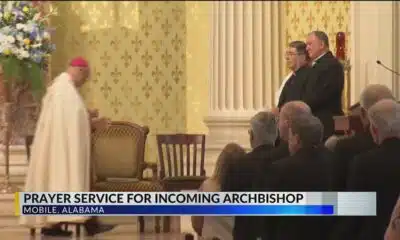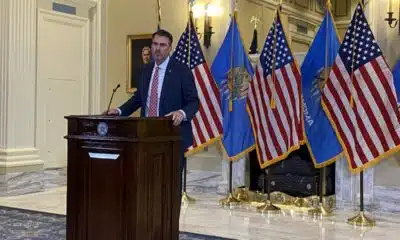News from the South - Texas News Feed
Proposed Transmission Line Threatens Texas’ Largest Reservoir
Houstonian Mike Peppercorn bought property along Lake Livingston in 2008, choosing timberland where his family would have privacy and pasture where they could raise cattle for Future Farmers of America projects. He and his neighbors with acreage along Barrett’s Landing Road all figured that surely this lake—which serves as a reservoir for the City of Houston 80 miles south—was an invaluable public resource that would forever be protected.
That seemed like a safe bet. Lake Livingston, an enormous impoundment of the Trinity River created in 1971, is surrounded by retirement homes, ranchettes, and sprawling RV parks. Part of its shoreline is a popular 635-acre state park, and its waters, stocked with bass, crappie, and catfish, are favored by Texas anglers’ for fishing tournaments.
The reservoir, the largest located entirely in Texas, is owned by the Trinity River Authority and is a major source of Houstonians’ drinking water.
So it shocked Peppercorn‚ and his neighbors Karl Van Brocklin, a retired engineer, and Randy and Ginny Lammers, when energy giant Entergy Texas Inc. (ETI) proposed building a high-powered electrical transmission line, up to 160 miles long, that would run right through their properties and the lake itself.
One of Entergy’s favored pathways for the project, dubbed the SETEX Area Reliability Route would cut across about a mile of the reservoir. And yet Entergy, records show,
didn’t ever bother to inform the City of Houston—which gets about 70 percent of the water produced by the reservoir—about its proposed lake routes.
Lammers, Peppercorn and Van Brocklin, all former Houstonians who regularly gather to share research in a barn-like workshop on Lammers’ property, worry about much more than the impact of unsightly poles and power lines on birds and on the people who live, boat, and fish here. They fear that its construction could unleash toxic threats buried in the lake’s sediment that could poison the fish and impair water quality for Houston residents—and for everyone downstream.
“All of these routes are 100 miles long. Going across the lake is one mile. For the safety of everybody’s drinking water, why go across the water?” Peppercorn said in an interview with the Texas Observer.
Until this small group reached out to Randy Macchi, director of Houston Public Works, city officials knew nothing about it. Entergy’s plans call for erecting a variety of steel structures that, if one of the lake routes are chosen, would be anchored to pilings and stand at least 75 to as much as 195 feet tall above the water and could create a mile-long path of obstacles between 125 and 250 feet wide.
After being informed by the Barrett’s Landing bunch, Macchi dispatched a letter of opposition expressing concerns that any route across the lake could adversely impact the city’s water supply. “The construction of powerlines across Lake Livingston could create many undesirable scenarios; none of which are in the best interest of HPW’s customers or the customers of other entities” that receive treated lakewater,” he wrote.
But the city’s letter of opposition arrived too late to be considered. Macchi, who did not respond to the Texas Observer’s request for comment, told KPRC he’s outraged that the utility’s failure to inform city officials shut them out. “There’s a regulatory process, and Entergy notified a lot of entities… The City of Houston was not one of them. And that’s troubling—because this isn’t just a lake; it’s our most critical water source.”

The contested project, part of Entergy’s plans to improve the grid that connects Entergy’s power plant in Willis with several counties in East Texas, is now under review by an administrative law judge at the State Office of Administrative Hearings. By August, the judge is expected to make a recommendation on the project to the Texas Public Utility Commission. But a look at the growing number of opponents to Entergy’s proposed Lake Livingston routes shows that Entergy thus far has done little testing to determine how the lake’s ecosystem might be affected by the construction or by the power line itself.
In the Texas Parks and Wildlife Department’s comment, the agency’s wildlife division director Alan Cain remarked that the company had done insufficient work to determine the impact on “important rare or protected species and their associated habitats”—including alligator snapping turtles and other creatures that live in or near the reservoir—along the more than 100-mile route proposal. The letter doesn’t specifically mention the Livingston reservoir.
Lake Livingston may look pristine. Indeed, park officials boast that its shoreline is home to multiple nesting pairs of Bald Eagles. Trinity Water Authority officials like to brag that big strides have been made to improve the quality of the river’s sometimes turbid water since the passage of the Clean Water Act in 1972.
But this huge reservoir’s waters are still troubled. Since 2017, it has been listed by the Texas Commission on Environmental Quality (TCEQ) as an impaired body of water—contaminated by cancer-causing dioxins and PCBs. In other words, it’s one of the lakes and rivers that the state has designated as needing more protection and clean-up to fully comply with the lofty aims of the Clean Water Act. In 2017, the TCEQ did a limited amount of testing of sediment in the lakebed, probing four sites for toxics, but those samples are miles away from the proposed route, according to a report posted online.
For even longer, an underfunded Texas fish-testing program has documented that some of this lake’s gar and even its prized species of catfish and bass are essentially too dangerous to be regularly eaten by anyone because of those same carcinogenic contaminants.
Though Lake Livingston and other East Texas lakes along the Trinity River continue to be popular for anglers, the state health department has issued periodic advisories warning children and women of child-bearing age not to eat gar and bass or catfish–and for all others to limit consumption. Surprisingly, Cain, the Texas Parks and Wildlife official who reviewed the proposed pipeline routes, doesn’t mention Lake Livingston or the fish studies that the park service has conducted there over the years.
The source of the poisons found in those fish issues is believed to be contaminated sediment in the bed of the lake—sediment that’s already frequently disturbed by floods and hurricanes but would be stirred up by the process of excavation and construction of those enormous metal towers and high-powered lines.
Entergy has also failed to consider that Lake Livingston is used for “recreational purposes”–despite the ubiquitous presence of fishermen, boaters and campers, according to documents filed by the Trinity River Authority (TRA) Attorneys representing the TRA, which opposes the route through the lake and favors alternatives, have objected that there was “no discussion of recreational uses of Lake Livingston itself and no discussion of boating or potential public safety hazards that would be created.” (The TRA did not immediately respond to the Observer’s request for comment).
For its part, Entergy insisted in a statement released to KPRC that “we are committed to transparency and continue to fully participate in the regulatory review process, which includes opportunities for public input and review of all routes under consideration.”
The utility company’s statement adds it was “also committed to complying with all federal and state environmental regulations, including any permitting requirements under the Clean Water Act. While route evaluation is ongoing and no final decision has been made, each proposed route—including lake and land crossings—is being thoroughly assessed based on a number of factors, including environmental impact, community input, engineering feasibility, and long-term reliability for our customers.”
Peppercorn argues that Texans who fish, live, and ultimately drink this water deserve more answers before the PUC approves construction through this large reservoir and popular recreation area. He and his neighbors argue that any other route would be better.
“We want a study on the water,” he told Observer. “There’s a lot of people who pull water on the Trinity River and on Lake Livingston–and not all of them have the sophistication of the City of Houston…Why not do the right things?”
The post Proposed Transmission Line Threatens Texas’ Largest Reservoir appeared first on www.texasobserver.org
Note: The following A.I. based commentary is not part of the original article, reproduced above, but is offered in the hopes that it will promote greater media literacy and critical thinking, by making any potential bias more visible to the reader –Staff Editor.
Political Bias Rating: Center-Left
This content primarily focuses on environmental concerns and government accountability related to a proposed energy infrastructure project. It highlights grassroots activism opposing corporate and utility power, emphasizes the protection of public natural resources like drinking water and wildlife, and critiques the lack of transparency from the energy company. The focus on environmental protection and regulatory oversight is consistent with a Center-Left perspective, which often values sustainability, public health, and community advocacy while expecting corporations and government agencies to act responsibly. However, the article maintains a measured, fact-based tone without strong partisan rhetoric or ideological extremes.
News from the South - Texas News Feed
By the numbers: Stats to know about the Texas Longhorns' 2025 season
SUMMARY: The Texas Longhorns football team is off to a 0-1 start this season, with no SEC games played yet. They average 7 points scored and 14 points allowed per game. Offensively, the team performs best in the fourth quarter, scoring all their points then, while defensively, they allow most points in the second and fourth quarters. The Longhorns rank No. 7 in the AP poll and No. 6 in the Coaches Poll. They trail opponents 65% of the game time, convert 26% of third downs and 17% of fourth downs, and have lost 50 yards to penalties. The highest attendance at DKR was 105,215 during the 2024 Texas-Georgia game.
The post By the numbers: Stats to know about the Texas Longhorns' 2025 season appeared first on www.kxan.com
News from the South - Texas News Feed
YouTube vigilantes help feds bust $65M scam ring targeting seniors
SUMMARY: Federal prosecutors in San Diego dismantled a $65 million international fraud ring targeting elderly Americans, aided by YouTube “scambaiters.” The 28 indicted members, mostly Chinese nationals, collaborated with India-based call centers using fake tech support and psychological tactics to steal money. Victims were tricked into returning supposed “extra” refunds via wire transfers, gift cards, or cash. Agencies including Homeland Security, FBI, and IRS arrested suspects across several states and seized over $4 million in assets. YouTubers from Scammer Payback and Trilogy Media helped identify key defendants by baiting scammers and exposing their operations, highlighting innovative law enforcement collaboration.
Read the full article
The post YouTube vigilantes help feds bust $65M scam ring targeting seniors appeared first on www.kxan.com
News from the South - Texas News Feed
Texas counties replace voting machines after Trump order
“Some Texas counties replace touchscreen voting machines after Trump order” was first published by The Texas Tribune, a nonprofit, nonpartisan media organization that informs Texans — and engages with them — about public policy, politics, government and statewide issues.
Sign up for The Brief, The Texas Tribune’s daily newsletter that keeps readers up to speed on the most essential Texas news.
This coverage is made possible through Votebeat, a nonpartisan news organization covering local election administration and voting access. Sign up for Votebeat Texas’ free newsletters here.
After years of using a touchscreen machine to mark their ballots, voters in at least three Texas counties will be asked instead to make their selections directly on the paper ballots, by hand, starting in November.
Election officials in Collin, Williamson, and Bastrop counties said they’re proactively changing their voting procedures and equipment in response to an executive order from President Donald Trump in March that sought to mostly ban voting equipment that uses barcodes or QR codes on paper ballots to speed up vote counting.
Some other provisions in the executive order have been blocked by the courts, but this one has not. The order instructed the U.S. Election Assistance Commission, which crafts the certification guidelines that most states rely on for their voting equipment, to amend the guidelines to prohibit such systems and “take appropriate action” to review and rescind previously issued certifications based on prior standards.
U.S. EAC Commissioner Donald Palmer told state election directors at a July conference that “there won’t be mass decertification of systems” in the near future. Still, Trump’s order has sparked questions from the public and uncertainty about the use of different kinds of voting machines.
Election officials have concerns, too, about the potential cost and complexity of having to switch voting systems. Some Texas counties, and officials in states including Ohio, California, and West Virginia, are opting to make changes now, in a year without a federal election, hoping to prevent disruption closer to the 2026 midterms.
“Every election is important, but you would never want to try such a big change for a primary election,” said Kaleb Breaux, election administrator in Collin County, north of Dallas, which is spending $2.3 million on the switch. “You want it to be a known process that your voters and people in your county trust.”
His department is planning to host events next month to give voters a chance to familiarize themselves with new equipment.
Touchscreen voting machines, barcodes and the Trump order
In most Texas counties — including the most populous — voters make their selections on touchscreen machines known as ballot-marking devices. At check-in, they receive a blank paper ballot that is inserted into the ballot marking device. Once a voter makes their selections on screen, the machine prints them out on the ballot for the voter to review. Then the voter inserts the ballot into the tabulation machine to be counted.
The counties potentially affected by Trump’s executive order use ballot-marking devices made by Elections Systems & Software, one of two state-certified voting system vendors. In addition to marking the ballots with the voter’s choices, the ES&S equipment prints a machine-readable code reflecting those choices that is used to speed up tabulation.
Critics of such systems have argued for years that voters have no way of knowing whether the code accurately reflects their choices, even though the results are audited.
ES&S told Votebeat that it is developing new equipment to meet the latest iteration of federal guidelines, and that it won’t use codes. Equipment from Hart Intercivic, the other state-certified vendor, doesn’t use machine-readable codes.
Both vendors also give counties the option of using paper ballots that voters mark by hand. Those systems still use tabulator machines to scan the ballots and count the votes.
Last month, Texas Elections Director Christina Adkins told a group of election officials that she’s waiting to see what action the federal EAC takes on certification of voting equipment in response to Trump’s executive order. Any change to the Voluntary Voting System Guidelines would immediately affect Texas’ certified voting systems, which must follow the federal guidelines under state law.
Adkins said voters across the state have been speaking at public meetings and have asked legislators about the part of the president’s executive order on machine-readable codes and paper ballots. She asked election officials to be prepared to answer questions from voters in their communities with accurate information about the order and how the state plans to respond.
Meanwhile, a Republican-led push to ditch all electronic voting equipment — including the tabulators — and hand count ballots instead, has made inroads in Texas. Gillespie County in the Texas Hill Country hand-counted thousands of ballots in the 2024 primary, but had to fix a series of errors in the results, which couldn’t easily be audited for accuracy because the ballots couldn’t be scanned by machines.
Different methods of voting in Texas
About 80% of Texas’ 254 counties use machines to mark voters’ choices on paper ballots. In the rest, including Denton County in North Texas and Cameron County in South Texas, voters mark the paper ballots by hand, and then put them in the tabulator for counting. (Even these counties must make at least one electronic voting machine available in each voting location to comply with the Americans with Disabilities Act.) .
Two small Texas counties — Limestone and Foard — don’t use paper ballots at all, but state law will require them to by next year.
Paper ballots, whether marked by a hand or a machine, are typically considered the gold standard for election security. They allow voters to check their selections before casting their ballot, and create a physical record for audits and recounts.
But is one way of marking ballots better than the other? Some election officials say that with hand-marked ballots, it’s harder to determine voter intent if there’s a doubt, or for a scanner to read the voter’s selections. On the other hand, some say hand-marked ballots allow voters to check for errors right away, rather than having to wait until they’re done voting and their ballot is printed out. And lines can move faster if people don’t have to wait for a machine.
Collin County prepares for the changes
In Collin County, a Republican-led community with 750,000 registered voters, the switch away from ballot-marking devices follows years of lobbying by activists urging the commissioner court to eliminate voting machines, even though the system has gotten high marks from the Texas Secretary of State’s Office.
A measure to make the change failed last year, but county officials approved a new one in June.
Trump’s executive order “was a bit of a catalyst for the court to revisit this move,” said Kaleb Breaux, the Collin County elections director.
As a result, 1,500 ballot-marking devices, which the county has used since 2019, will be put in storage. The county will still use about 300 of them at polling locations to comply with federal law on disability access. Trump’s executive order allows leeway for that, as long as the machines produce a voter-verifiable paper record.
The $2.3 million the county is spending includes the purchase of voting booths, printers, laptops, and other election materials. Breaux said the voting booths take up less space than the voting machines, so polling locations can accommodate more voters than before.
However, he wants to encourage voters to take their time marking their ballots in November to avoid problems tallying later. “Make sure they’re bubbling everything in completely,” he said. “And if they mess up their ballot, don’t be afraid to ask for another one.”.
Breaux said he hopes the new method of voting can help boost voter trust.
“I think what we had worked well,” he said, “but I also think this is going to work just as well for our voters and our workers.”
Natalia Contreras is a reporter for Votebeat in partnership with the Texas Tribune. She is based in Corpus Christi. Contact Natalia at ncontreras@votebeat.org
More all-star speakers confirmed for The Texas Tribune Festival, Nov. 13–15! This year’s lineup just got even more exciting with the addition of State Rep. Caroline Fairly, R-Amarillo; former United States Attorney General Eric Holder; Abby Phillip, anchor of “CNN NewsNight”; Aaron Reitz, 2026 Republican candidate for Texas Attorney General; and State Rep. James Talarico, D-Austin. Get your tickets today!
TribFest 2025 is presented by JPMorganChase.
This article originally appeared in The Texas Tribune at https://www.texastribune.org/2025/09/02/trump-election-executive-order-texas-voting-machines/.
The Texas Tribune is a member-supported, nonpartisan newsroom informing and engaging Texans on state politics and policy. Learn more at texastribune.org.
The post Texas counties replace voting machines after Trump order appeared first on feeds.texastribune.org
Note: The following A.I. based commentary is not part of the original article, reproduced above, but is offered in the hopes that it will promote greater media literacy and critical thinking, by making any potential bias more visible to the reader –Staff Editor.
Political Bias Rating: Centrist
This content presents a balanced and factual report on changes in voting procedures in Texas counties prompted by a Trump executive order. It includes perspectives from election officials, relevant legal context, and both criticisms and defenses of touchscreen voting machines without promoting a partisan viewpoint. The language is neutral and focuses on informing readers about the logistical and regulatory aspects of election equipment changes, reflecting a centrist approach to political news coverage.
-
Mississippi Today3 days ago
DEI, campus culture wars spark early battle between likely GOP rivals for governor in Mississippi
-
News from the South - North Carolina News Feed6 days ago
Parasocial party: Why people are excited for the Taylor Swift, Travis Kelce engagement
-
News from the South - Louisiana News Feed6 days ago
K+20: Katrina alters local health care landscape, though underlying ills still the same
-
Our Mississippi Home7 days ago
The Great Backyard Recovery – Helping Birds After the Storm
-
Local News Video5 days ago
08/29 Ryan's “Wet End to the Week” Friday Forecast
-
Local News6 days ago
Police say Minneapolis church shooter was filled with hatred and admired mass killers
-
The Center Square7 days ago
U-M Health ends transgender treatment for minors | Michigan
-
News from the South - Alabama News Feed7 days ago
Katrina displaced 1.5M across the South, only 61% returned to New Orleans | Louisiana










































